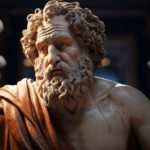Abbé Sieyès, a clergyman turned revolutionary, profoundly shaped the French Revolution through his influential political theory of popular sovereignty and his pivotal pamphlet What is the Third Estate?. While other figures delivered fiery speeches, Sieyès wielded his pen like a scalpel, dissecting the very fabric of French society and exposing the inequities that would ultimately ignite the revolution. This is the story of the quiet revolutionary, the priest who helped topple a kingdom, and the complex figure who navigated the tumultuous currents of his time.
The Genesis of a Revolutionary Mind
Emmanuel Joseph Sieyès, later known as Abbé Sieyès, was born in Fréjus, France, on May 3, 1748, the fifth child of a tax collector. His modest upbringing belied the intellectual heights he would later achieve. Educated first privately by Jesuits and then at the Seminary of Saint-Sulpice in Paris, Sieyès received a rigorous education in theology and engineering. This eclectic mix of disciplines likely fostered his multifaceted intellect, enabling him to bridge theoretical thought and practical political maneuvering. Though ordained a priest in 1773, he found himself increasingly drawn to the burgeoning ideas of the Enlightenment, a period of intellectual ferment that emphasized reason, individual liberty, and questioned traditional authority. This exposure probably fostered his revolutionary spirit and desire to reshape French society.
The Voice of the Third Estate
By 1788, France was a nation teetering on the brink of revolution. Decades of economic mismanagement, royal extravagance, and deep-seated social inequalities had created widespread resentment. Into this volatile atmosphere, Sieyès launched his literary bombshell: Qu’est-ce que le Tiers-État? (What is the Third Estate?), published in January 1789. This concise yet potent pamphlet became a rallying cry for the common people, the Third Estate, posing three fundamental questions that resonated deeply with the nation: “What is the Third Estate? Everything. What has it been hitherto in the political order? Nothing. What does it desire to be? Something.”
Sieyès argued that the Third Estate—the commoners who comprised the vast majority of the population—constituted the true nation of France. They were the ones who worked the land, paid the taxes, and yet, held very little political power. He demanded that their representation in the Estates-General, the French assembly, reflect their actual power and importance. The pamphlet, with an estimated one million readers, ignited revolutionary sentiment. It is difficult to ascertain the full extent to which Sieyès anticipated its impact, but it undoubtedly served as a catalyst for the momentous events that followed.
Sieyès in the Crucible of Revolution
Sieyès was no mere pamphleteer; he was a man of action. Elected as a representative of the Third Estate to the Estates-General, he immediately championed the formation of the National Assembly, a unified body representing the entire nation. This act of defiance against royal authority marked a critical turning point in the revolution. He was instrumental in drafting the Declaration of the Rights of Man and of the Citizen, a document enshrining the principles of liberty, equality, and popular sovereignty, ideals rooted in Enlightenment philosophy that continue to inspire democratic movements globally. However, as the revolution became increasingly radical, some historians suggest that Sieyès, perhaps unnerved by the very forces he had unleashed, began to have misgivings, grappling with whether the revolution had deviated from its original aims.
The Gamble with Napoleon
Disillusioned with the escalating violence and instability of the Reign of Terror, Sieyès looked to the ambitious young general, Napoleon Bonaparte, as a potential source of stability and order. He became the architect of the coup of 1799, which installed Napoleon as First Consul. It’s likely he believed this move would preserve the gains of the revolution while curbing its excesses. Initially serving in Napoleon’s government, Sieyès hoped to shape the new regime. However, Napoleon’s thirst for power proved insatiable, and Sieyès found himself increasingly marginalized. Historians continue to debate whether Sieyès was politically naïve or simply outmaneuvered by a more cunning and ruthless operator.
A Legacy of Contradictions
Abbé Sieyès’s legacy remains a tapestry of intriguing contradictions. He was a champion of popular sovereignty who facilitated the rise of an authoritarian leader; a man who helped dismantle the old order yet yearned for stability. His lesser-known works offer glimpses into a complex intellect grappling with the realities of political power and social transformation. Did his actions betray his ideals, or were they pragmatic choices in extraordinary circumstances? These questions continue to fuel scholarly debate. Regardless, Sieyès’s profound influence on French political thought and the development of modern democracy remains undeniable. His story serves as a potent reminder of the enduring power of ideas, even those born of contradiction.
Mirabeau and Sieyès: A Comparison
Abbé Sieyès and Honoré Gabriel Riqueti, comte de Mirabeau, were both pivotal figures in the French Revolution, yet their approaches differed dramatically. Sieyès, the clergyman, was primarily a theorist and writer, wielding his pen to articulate the frustrations of the Third Estate and lay the intellectual groundwork for revolution. Mirabeau, the nobleman turned advocate for the commoners, excelled as an orator and politician, navigating the complexities of the National Assembly and advocating for a more moderate approach. Their views on the monarchy also diverged. Sieyès favored a severely limited or abolished monarchy, while Mirabeau believed a constitutional monarchy offered a more stable path forward. Their contrasting paths—Sieyès retreating from public life as the revolution radicalized and Mirabeau thriving in the political arena until his death in 1791—further underscore their different approaches. While Sieyès provided the blueprint, Mirabeau attempted to be the builder. Had he lived, some speculate the Reign of Terror might have been mitigated, although this remains a hypothetical scenario given the complex factors at play.
| Feature | Abbé Sieyès | Honoré Mirabeau |
|---|---|---|
| Year of Birth | 1748 | 1749 |
| Social Class | Clergy | Nobility |
| Primary Role | Theorist, Writer | Orator, Politician |
| View of Monarchy | Limited/Abolished | Constitutional |
| Political Style | Intellectual | Pragmatic |
The Power of What is the Third Estate?
Sieyès’s What is the Third Estate? was more than just a pamphlet; it was a revolutionary manifesto. Published in January 1789, it became a cornerstone of the revolutionary movement, challenging the existing social and political hierarchy by asserting the importance of the common people. With approximately 300,000 copies in circulation and an estimated one million readers, it captured the zeitgeist of a nation on the brink of change. The pamphlet propelled Sieyès to a position of leadership, playing a key role in the formation of the National Assembly and the drafting of the Declaration of the Rights of Man and of the Citizen. While his later support for Napoleon remains a controversial aspect of his legacy, the impact of What is the Third Estate? is undeniable, a testament to the power of ideas to shape history.
Pronouncing Sieyès
The correct pronunciation of Sieyès is approximately “see-yes,” with the “y” resembling the vowel sound in “beet.” The International Phonetic Alphabet (IPA) offers a more precise rendition. The honorific “Abbé” preceding his name signifies his status as a clergyman. Mastering the pronunciation demonstrates an appreciation for the historical context and respect for Sieyès’s contributions to the French Revolution.
“What is the Third Estate?” a pamphlet authored by E. J. Sieyès in 1789, played a pivotal role in shaping the French Revolution. It challenged the existing social and political hierarchy by asserting the importance and power of the common people. This publication is considered a key text in understanding the intellectual and ideological underpinnings of the revolution.
Delve into the gripping narrative of appointment in samarra and uncover the historical significance of Absalom’s monument, a testament to ambition and rebellion.
- Amazing March Fun Facts: Unveiling History & Celebrations - April 15, 2025
- Master how to write height: A complete guide - April 15, 2025
- How High Are Your Standards Test: Find Your Perfect Match Now - April 15, 2025
















